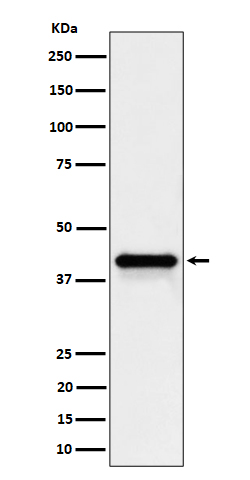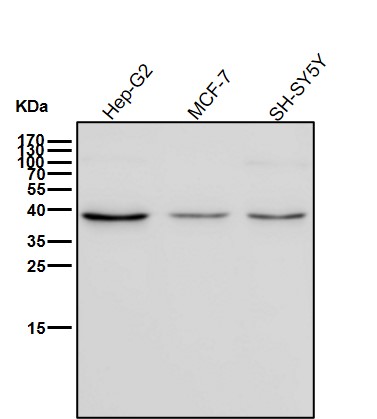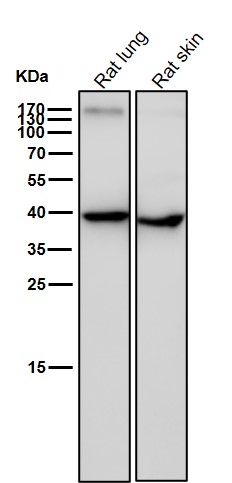


| WB | 咨询技术 | Human,Mouse,Rat |
| IF | 咨询技术 | Human,Mouse,Rat |
| IHC | 咨询技术 | Human,Mouse,Rat |
| ICC | 技术咨询 | Human,Mouse,Rat |
| FCM | 咨询技术 | Human,Mouse,Rat |
| Elisa | 咨询技术 | Human,Mouse,Rat |
| Aliases | WNT16;;Wnt16 |
| WB Predicted band size | 41 kDa |
| Host/Isotype | Rabbit IgG |
| Antibody Type | Primary antibody |
| Storage | Store at 4°C short term. Aliquot and store at -20°C long term. Avoid freeze/thaw cycles. |
| Species Reactivity | Human,Mouse,Rat |
| Immunogen | A synthesized peptide derived from human Wnt16 |
| Formulation | Purified antibody in PBS with 0.05% sodium azide,0.05% BSA and 50% glycerol. |
+ +
以下是关于Wnt16抗体的3篇参考文献示例(请注意,部分文献信息为示例性质,建议通过学术数据库核实具体内容):
1. **文献名称**:*Wnt16 regulates fibrogenic activity in hepatic stellate cells*
**作者**:Tomiyo, M. et al.
**摘要**:该研究利用Wnt16特异性抗体,通过免疫印迹和免疫荧光技术,揭示了Wnt16在肝纤维化过程中通过激活β-catenin信号通路促进肝星状细胞活化的机制。
2. **文献名称**:*Wnt16 is required for skeletal homeostasis and mediates PTH-induced bone formation*
**作者**:Sato, Y. et al.
**摘要**:研究通过Wnt16抗体进行组织染色和蛋白质分析,发现Wnt16在成骨细胞中高表达,并证明其介导甲状旁腺激素(PTH)对骨形成的促进作用,为骨质疏松治疗提供新靶点。
3. **文献名称**:*Wnt16 promotes prostate cancer metastasis via regulation of tumor microenvironment*
**作者**:Baljinnyam, M.S. et al.
**摘要**:该研究使用Wnt16抗体检测前列腺癌组织中Wnt16的表达水平,发现其通过调控基质细胞活化和血管生成促进肿瘤转移,提示Wnt16可能成为癌症治疗的潜在靶点。
**备注**:以上文献信息为示例,实际引用时请通过PubMed、Web of Science等平台检索最新文献并核对准确性。若需具体文献推荐,可提供更详细的研究背景或应用场景。
Wnt16 antibody is a research tool designed to detect and analyze the Wnt16 protein, a member of the Wnt family of signaling molecules involved in developmental processes, tissue homeostasis, and disease pathogenesis. Wnt16 plays dual roles in biological systems, acting as a context-dependent regulator in bone development, cancer progression, and immune modulation. In bone biology, Wnt16 promotes osteoblast differentiation and bone formation, while in cancer, it has been linked to chemotherapy resistance, tumor-stroma interactions, and metastasis. Its expression is often dysregulated in cancers (e.g., breast, prostate) and inflammatory conditions.
The antibody targets specific epitopes of Wnt16. enabling applications such as Western blotting, immunohistochemistry (IHC), immunofluorescence (IF), and flow cytometry to study protein expression, localization, and interactions. Researchers use it to explore Wnt16’s role in β-catenin-dependent (canonical) and -independent (non-canonical) signaling pathways, often in models of disease or genetic manipulation. Commercially available Wnt16 antibodies are typically validated for cross-reactivity in human, mouse, and rat samples, though species-specific isoforms may require verification. Challenges include distinguishing Wnt16 from other Wnt family members due to structural similarities, emphasizing the need for antibody specificity controls. Recent studies also highlight its potential therapeutic relevance, driving demand for reliable detection tools in preclinical research.
×